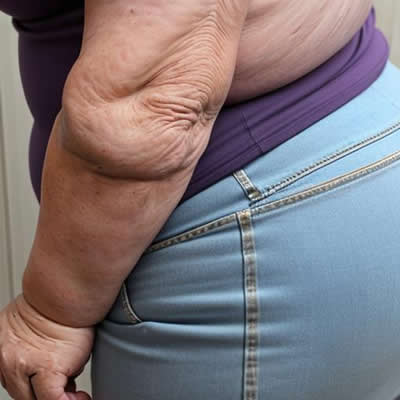Arm Lift Surgery, also known as Brachioplasty, is a cosmetic procedure that aims to reshape and tighten the upper arms.
Arm Sagging
Sagging arms or flabby arms are a common cosmetic problem that can affect both men and women. This condition can occur for a variety of reasons, including aging, weight fluctuations and genetics. When the skin loses its natural elasticity, it becomes more prone to sagging, leaving the arms with a flabby and saggy appearance.
As we age, our skin gradually loses collagen and elastin, two proteins responsible for maintaining its firmness and elasticity. This natural aging process, combined with the effects of gravity, can lead to saggy skin on the arms. In addition, significant weight loss or gain can cause the skin to stretch or shrink rapidly, leading to flabby and saggy arms.
Genetics also plays a role in determining the likelihood of developing sagging arms. Some individuals may be genetically predisposed to have less elastic skin, making them more prone to sagging as they age. Others may have a family history of sagging arms, which makes them more likely to have this sagging problem.
While regular sport and exercise can help tone the muscles underlying the arms, it is often not enough to completely eliminate arm sagging. This is because sports and exercise primarily target the muscles and do not address the excess skin and fat that contribute to the saggy appearance.

What You Should Know Before Arm Lift Surgery
Arm sagging can be classified into three categories according to its severity: mild, moderate and severe. Mild cases may only require non-surgical treatments such as exercise and skin-tightening creams, while more severe cases usually require surgical intervention. The severity of arm sagging is determined by various factors such as genetics, age, weight fluctuations and overall skin elasticity.
During the consultation with the plastic surgeon, you should clearly describe your individual goals and medical history. The surgeon will assess the degree of arm sagging and determine whether you are a suitable candidate for Arm Lift Surgery. They will carefully examine the quality of your skin, the amount of excess fat and the presence of any underlying medical conditions that may affect the surgical outcome.
It is very important to have realistic expectations and be prepared for the recovery process that follows the procedure.
After surgery, you will need to follow specific post-operative instructions provided by your surgeon. This may include wearing compression garments to reduce swelling and promote healing, avoiding strenuous activities for a certain period of time, and taking prescribed medications to manage pain and prevent infection.
Arm Lift Surgery Procedure
The Arm Lift Surgery procedure involves several steps to achieve the desired results. First, the surgeon will administer anesthesia to keep you comfortable throughout the surgery. Next, an incision is made along the inner or back part of the arm, depending on the specific case.
Once the incision is made, excess skin and fat are carefully removed. The underlying tissues are then tightened and reshaped to create a more defined arm contour. The incision is closed with sutures and the arms are wrapped in a compression garment to minimize swelling and aid the healing process.
Possible Risks and Complications
As with any surgical procedure, there are potential risks and complications associated with Arm Lift Surgery. These include infection, bleeding, scarring and adverse reactions to anesthesia. However, choosing a qualified and experienced plastic surgeon reduces the likelihood of such complications.
Recovery Process After Arm Lift Surgery
The recovery process following Arm Lift Surgery requires patience and adherence to post-operative care instructions. Swelling, bruising and discomfort in the arms are normal and can be managed with prescribed pain medication and cold compresses.
Your surgeon may recommend an arm brace for a few weeks to help with swelling and provide support to the arms during the healing process. It is important to avoid strenuous activities and heavy lifting for at least four to six weeks to ensure proper healing.
What is a Mini Arm Lift?
Mini Arm Lift, also known as Mini Brachioplasty, is a less invasive version of the traditional Arm Lift Surgery. This procedure is suitable for people with mild arm sagging or who prefer a smaller incision and less scarring. The Mini Arm Lift involves a smaller incision and focuses on removing excess skin and fat from the upper arm.
During your consultation, your surgeon will assess your specific needs and goals to determine if a Mini Arm Lift is a suitable choice for you. They will explain the procedure in detail and discuss the expected results and recovery process.
Non-Surgical Arm Lift Procedures
In addition to surgical options, non-surgical arm lift procedures such as skin tightening treatments and injectables are also available. These procedures use various technologies, including radiofrequency and ultrasound, to stimulate collagen production and tighten the skin.
Non-surgical arm lift procedures offer minimal downtime and can be a viable alternative for individuals with mild arm sagging. However, it is important to note that the results of non-surgical treatments can be temporary and may require ongoing maintenance sessions to maintain the desired result.
Cost of Arm Lift Surgery in Turkey
The cost of Arm Lift Surgery in Turkey can vary depending on several factors, including the surgeon’s expertise, location and the complexity of the procedure. However, the average varies between $3,000 and $8,000. During your consultation, your surgeon will provide you with a detailed breakdown of the costs involved, including the surgeon’s fee, anesthesia fees, facility fees, and post-operative garments.
When considering Arm Lift Surgery, it is important to prioritize quality of care and the surgeon’s experience over cost alone. Many practices offer financing options to make this procedure more accessible and manageable for patients.
